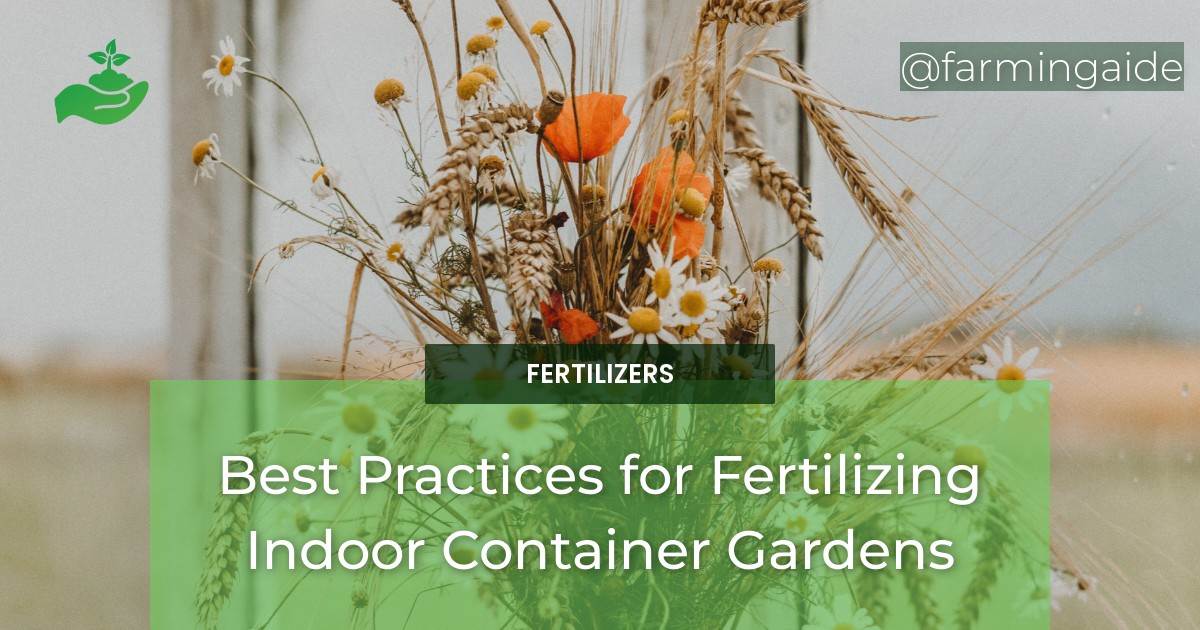Container gardening is a great way for urban dwellers to enjoy the benefits of indoor gardening. Whether you have a small balcony or a spacious apartment, indoor container gardening can add a touch of greenery to your living space. Fertilizing indoor container gardens is essential for the proper growth and development of plants, and it can be quite challenging for beginners. In this article, we will discuss the best practices for fertilizing indoor container gardens. We will cover unique considerations for indoor container gardening, choosing the right fertilizers, preventing indoor air pollution, and best practices for fertilizing. By following these best practices, you can ensure that your indoor container garden thrives and adds beauty to your living space.
Unique Considerations for Indoor Container Gardening
Indoor container gardening has its unique challenges that you need to consider to ensure the success of your garden. Here are some unique considerations for indoor container gardening:
Limited Space and Light
Indoor container gardens are often restricted by limited space and light. It is essential to choose plants that can thrive in low light conditions and fit into small spaces. You should also consider the placement of your plants in your living space to ensure they get enough sunlight.
Choosing the Right Containers
Choosing the right containers is essential for the success of your indoor container garden. You should choose containers that are the right size and shape for your plants. You should also consider the material of the containers, as it can affect the drainage and moisture retention of your soil.
Optimal Soil Mix for Indoor Container Gardening
The soil mix you use for your indoor container garden is crucial for the growth and development of your plants. You should choose a soil mix that is well-draining and has the right balance of nutrients for your plants. You can make your soil mix or buy a ready-made mix from your local garden center.
Choosing Indoor-Friendly Fertilizers
Choosing the right fertilizers for your indoor container garden is crucial for the health and growth of your plants. Here are some factors to consider when choosing indoor-friendly fertilizers:
Understanding N-P-K Ratio
The N-P-K ratio is the ratio of nitrogen, phosphorus, and potassium in a fertilizer. Understanding this ratio can help you choose the right fertilizer for your plants’ specific needs. For example, nitrogen is essential for foliage growth, while phosphorus is essential for root development.
Organic vs. Synthetic Fertilizers
Organic fertilizers are made from natural materials and are often slower-releasing than synthetic fertilizers. They are often more expensive but can improve the health of your soil in the long run. Synthetic fertilizers are made from chemicals and are often cheaper and faster-acting. However, they can harm the environment and cause indoor air pollution.
Slow-Release vs. Water-Soluble Fertilizers
Slow-release fertilizers release nutrients over time and can provide your plants with a steady supply of nutrients. Water-soluble fertilizers dissolve quickly in water and can provide your plants with an immediate nutrient boost. You should choose the right type of fertilizer based on your plants’ specific needs.
ALSO READ
Preventing Indoor Air Pollution
Indoor air pollution is a common problem in indoor container gardening. Chemical fertilizers can release harmful toxins into the air and harm your health. Here are some ways to prevent indoor air pollution:
Harmful Effects of Chemical Fertilizers
Chemical fertilizers can harm your health and the environment. They can release harmful toxins into the air, water, and soil, and cause indoor air pollution. They can also harm beneficial insects, animals, and microorganisms in your soil.
Natural Alternatives to Chemical Fertilizers
There are several natural alternatives to chemical fertilizers that you can use in your indoor container garden. Organic compost, worm castings, and fish emulsion are all excellent natural fertilizers that can improve the health of your soil and plants.
Proper Ventilation Techniques for Indoor Container Gardening
Proper ventilation is essential to prevent indoor air pollution. You should open your windows and doors regularly to let fresh air into your living space. You can also use air purifiers and fans to improve the air quality in your home.
What Are the Best Practices for Fertilizing Seedlings in Indoor Container Gardens?
When fertilizing seedlings in containers, dos and don’ts are important to consider. Do follow the recommended dilution rates for liquid fertilizer to avoid burning the delicate roots. Don’t over-fertilize, which can lead to nutrient imbalances. Always use a gentle touch when feeding seedlings to encourage healthy growth.
Best Practices for Fertilizing Indoor Container Gardens
Here are some best practices for fertilizing indoor container gardens:
Knowing When to Fertilize
You should fertilize your indoor container garden when your plants are actively growing. You can also fertilize your plants during the flowering and fruiting stages to encourage the development of flowers and fruits.
Proper Application Techniques
You should apply your fertilizer according to the instructions on the package. Over-fertilizing your plants can harm them and cause indoor air pollution. You should also water your plants thoroughly after fertilizing to distribute the nutrients evenly.
Monitoring Plant Health and Adjusting Fertilizer Use
You should monitor your plant’s health regularly and adjust your fertilizer use accordingly. Signs of over-fertilization include yellowing leaves, stunted growth, and burnt roots. If you notice any of these signs, you should reduce your fertilizer use and improve your soil’s drainage.
Indoor container gardening can be a rewarding and enjoyable activity. By following the best practices for fertilizing your indoor container garden, you can ensure that your plants thrive and add beauty to your living space.
RELATED ARTICLES:


